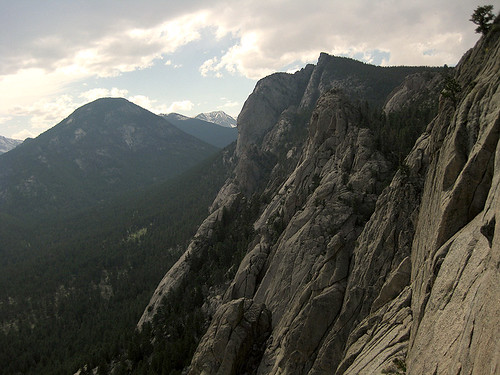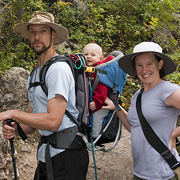Climbing the Pear Buttress
In which Kate continually redefines the “scariest thing I have ever done.”
Mark and I have spent a fair amount of time climbing on the giant granite rocks just north of Estes Park known as Lumpy Ridge. We’ve manage to climb a few easy and a couple classic routes over the years, but we’ve never found a route that made the area truly special, until we climbed the Pear Buttress (5.8+).
Note: It is important to keep some facts in mind for those who may have visited Lumpy before. The Pear is a rock formation with a classic 5.7 that climbs to the top of it. The Pear Buttress is a route on a different rock formation called The Book, and goes at harder and more sustained grade. It doesn’t have to make sense, it simply is.
Mark and I were proud of ourselves when we managed to show up at the Trailhead for Lumpy at around 9am. There were other climbers milling about, and we ended up hiking in a long line people up to the base of the Book. We noticed as we left the car that we had forgotten both our guidebook and the printed copy of the route description that I made on Friday. It was a nice Saturday in the National Park, so we figured we would just follow other climbers up this wildly popular route. And after seeing the number of people at the bottom of the climb, we knew our plan would work.
The first pitch of this climb has no protection until 20 or 30ft up. Watching Mark climb this steep, thin slab from the ground was very scary. I held my breath and held my hands up the whole time, convinced that if he did fall, I would at least be beneath him before he hit the ground. Mark, as usual, didn’t mind the high first piece, and climbed as if he were on toprope. When he finally got his gear in and I started breathing again, I declared that to be “the scariest thing we have done all year!”
The rest of the first pitch is fun flake hand-jams and then the crux, or hardest part, of the whole climb comes at the top of the pitch when you are forced to climb very thin cracks on a slippery rock face before making it up to the belay ledge.
The second pitch traverses left along a sloping ledge 150ft in the air. I was feeling confidant, and had no problems until the ledge reaches the edge of the huge slab of rock we were climbing on. The route then ascends the corner of the 1000ft tall slab of granite, with air below you on all sides. Mark admitted that he felt “exposed” during this section of the climb, and I trembled and slowly worked my way up and then across an airy traverse and then down to the belay. I knew I was safe on a rope and seconding the fairly easy climbing on this pitch, but the route hung out over so much empty space that it was nearly impossible to keep your mind off of the image of a tumbling demise. Once I reached Mark, I clipped myself into the fixed anchor and decided that this section was “THE scariest thing I have done in a very long time!”
The third pitch was the “money pitch,” a 160ft long hand crack that splits the blank face of the rock. It starts with thin hands about an inch wide and slowly widens to perfect cupped hands near the top. Mark led the pitch like the crack master that he is, quickly and quietly working his way up the beautiful formation. When it was my turn to second the pitch, I found my crack climbing rhythm, and moved up the rock at a good pace. After the first 30ft, I found my breathing and heart rate had increased and I felt like I was climbing at an aerobic pace. After the first 60ft, my toes were sore and my calves had begun to cramp. After 90ft of crack climbing, my right groin muscle had begun to spasm and shoot pain through the right side of my body whenever I lifted my right leg, and when I finally reached the top of the crack, I was sweating, panting, and pushing my physical limits past what I ever thought I could endure. It was a fantastic pitch!
The last few pitches got us up and off the top of the rock. Mark and I decided to give the Cave Exit a try, and after his adventures in stemming, I thought I would let him write his own post about the exit. Look for that one to show up soon. I was so sore and exhausted by the time I reached the critical point on the last pitch, I didn’t think I could do it. I stood on a little rock, reaching out to a shelf that hung out over the 800ft of air we had just worked so hard to ascend, and had to hang upside down and pull myself over the lip. I screamed in pain, terror and effort as I pulled over the roof, and then topped out a fantastic climb with a rush of adrenaline stronger than any in years.
I was thrilled and goofy on top of the rock. I yelled profanities to the wind, jumped up and down, and took about a million pictures and some goofy video. I decided that roof was “THE SCARIEST THING I HAVE EVER DONE!” and felt so happy and proud for completing the climb.
In the end, this route fit all of my requirements for a “great climb” without any doubt. We worked hard, with sustained physical effort, and it took everything we had, all of our mental, physical and emotional power, to finish it. It topped out on an amazing and beautiful summit. And Mark and I got to enjoy it together. Score one for Lumpy Ridge!








6 Comments